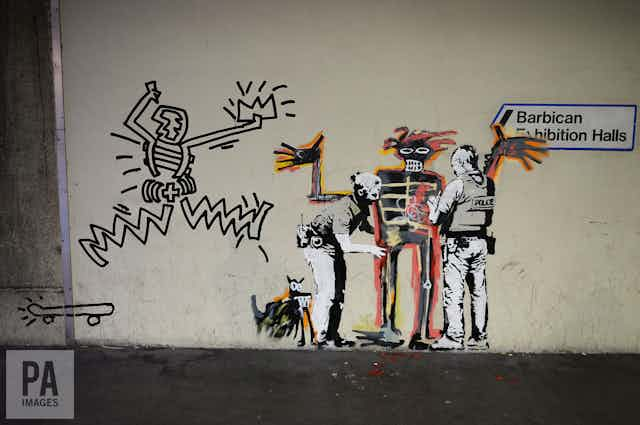Banksy is back, in his own iconic style.
Two murals by the British street artist have been spotted on the walls of the Barbican Centre in London, which is hosting Boom for Real, a major exhibition dedicated to the genius of American artist Jean-Michel Basquiat.
The first mural represents a ferris wheel (with Basquiat-inspired crowns replacing the wheel’s passenger cars) with people queuing up at the ticket booth. It makes fun of the exhibition’s organisers, confirmed by Banksy’s Instagram post presenting the new artwork: “Major new Basquiat show opens at the Barbican – a place that is normally very keen to clean any graffiti from its walls.”
Basquiat himself started his career in the 1970s spraying artworks, messages and tags in the streets of New York City, often with his schoolmate and graffiti artist Al Diaz.
The second Barbican mural depicts a figure being frisked by two policemen, which bears more than just a likeness to Basquiat’s 1982 piece, Boy and Dog in a Johnnypump. Again, Banksy seems to mock the exhibition celebrating a former graffiti artist, highlighting how harshly street artists – who frequently face serious legal consequences including jail time – are treated by the police.
Saving valuable art?
Would it be possible to prevent the removal of Banksy’s new creations? It is difficult to foresee what the fate of these potentially very valuable murals will be. The walls belong to the City of London Corporation, which has not yet decided whether to keep them or even protect them. As has often happened in the past with Banksy’s street artworks, they may soon be cut from the wall, exhibited and then offered for sale for six-figure sums.
The elusive Bristol street artist has strongly disapproved of such removals. But he has never taken legal action to try to prevent removal by relying on copyright and moral rights laws.
This is probably due to the fact that Banksy often paints his murals illegally, namely without the authorisation of the owner of the wall, which exposes him to prosecution for defacement of property. Plus, he believes that copyright law is “for losers”.
But let’s imagine for a minute that Banksy changes his mind and wants to react in court against the removal and “indoor-isation” of his murals. Could he successfully invoke the so-called “integrity right”, which allows artists to oppose treatment of artworks that are prejudicial to their honour or reputation?
On the one hand, he could argue that his reputation is harmed by such treatment of his street artworks, as the public may think he has condoned it, which would tarnish his anti-establishment and anti-consumerist image.
On the other, the copyright statute does not expressly provide artists with the ability to oppose the exhibition, or in general publication, of their works in contexts different from those chosen by the artists themselves: which may represent an obstacle in any proceedings against someone who exhibits Banksy’s removed murals.
Could the Basquiat estate sue Banksy?
But could Banksy find himself embroiled in a legal fight for an alleged copyright infringement? We have seen how his own murals have incorporated an entire Basquiat work and the stylised crowns used and popularised by the American artist.

The first issue is related to Banksy’s anonymity. Should the Basquiat estate plan on going after the famous British artist, who should they sue? Despite various theories surrounding his identity, nobody outside his inner circle really knows who Banksy is. That may not be an insurmountable obstacle, though. A legal action could probably be started against the entity behind the banksy.co.uk website and the related Instagram account which are displaying pictures of the murals.
Also, far from just being an homage to Basquiat and a lawful use of a copyrighted work (for example, under the fair dealing exception for criticism or review), the two murals, especially the one depicting the figure frisked by two police officers, might be considered as unlawfully reproducing substantial parts of copyright-protected pieces of art. Canvases, prints, posters and even tea cups depicting Banksy’s murals can already be readily found on the internet, produced by people not linked to the street artist.
Most probably, such legal action will never get up much steam. The Basquiat estate will find it counter-productive to pick up a legal fight with the most appreciated urban artist in the world. They may be quite happy with the increased interest the murals have garnered for the current exhibition.
But street artists like Banksy who frequently incorporate in their murals copyrighted works of others may soon need to pay more attention if they want to avoid getting into legal troubles. The more graffiti artists enter the mainstream and increase their notoriety, the higher the chances they will receive complaints and be condemned if their works infringe others’ copyright.
Whatever happens to Banksy’s murals, I wonder what Basquiat, if he were around today, would make of all this. He might have been delighted about the clever murals, having started out himself as a graffiti artist. Or he might have thanked Banksy for creating a nice media-friendly buzz for his exhibition. But as an artist who later successfully entered the professional art market, and understood its driving forces, Basquiat might also think: “Hey Banksy, that’s my stuff. That’s not cool.”

